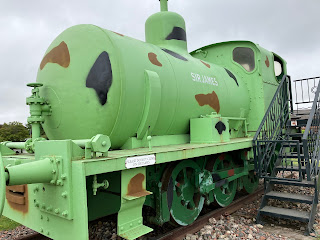From Oban and heading further south to Dumbarton, just outside Glasgow. We found our first view of Highland cattle, we hadn’t seen any before as the east of Scotland tended towards crop growing. Along with a ruined castle these cattle were almost lost in the long grass. This was near Loch Awe.
We drove alongside Loch Lomond, but the areas where we could stop didn’t have the views the other lochs had. When we reached Dumbarton, we were wondering what to see there and found the Scottish Maritime Museum, which contains the Denny Ship Model Experimental Tank, which tested ship hull models. A fascinating place which had been used since Victorian times up until 1990’s and was in the heart of the Clyde shipbuilding area. Surprisingly there was a quilt. Part of a project involving the local community, called Skylark.
In the former offices, were all sorts of items for calculations, technical drawings, a machine for making graph paper as well as organised storage for reference drawings. I couldn’t resist this picture of an enormous calculator. Just to think that nowadays you can just us an app on your phone! We stayed a few days so we could go to Glasgow but it wasn’t quite how we planned. David wanted to visit the transport museum at the Riverside and also The Burrell Collection. We first of all found that public transport didn’t go to the Riverside, only the sightseeing buses. Parking was available by either cash or app, not contactless card (why?), so that restricted us on staying for one and not going to the other.
But while in the city centre we later took a loooong walk to Kelvingrove Art Gallery and Museum (when we could have taken the bus (which we did going back to the city. Before then we ended up in the Willow Tea Rooms, designed by Charles Rennie Mackintosh.
We didn’t have a reservation but there was a table for 2 and we were lucky as it was heading towards lunchtime and there was a queue.
We also went to Glasgow Central station just to look at the building, not catch a train.
Kelvingrove was an amazing place with people standing in the entrance to listen to the pipe organ. I think it must be the only place where you can see an elephant and a Spitfire plane together.
And look at all those heads, all different expressions The cover for the heating system (yes, it was that ornate)And himself photobombed me taking this photo of an Arts and Crafts mirror.
There was a small collection called Make Do and Mend and I could not resist taking a photo of what is now called visible mending, this is a darning sampler.
So that was our day in Glasgow, and return visit to what was the docks area for the Riverisde, home of the Transport Museum. Our woes continued with not only the parking, but also on Friday the museum opens an hour later so we didn’t have as much as wanted. It is a modern building and a lot crammed in with cars being on a ‘car wall’ and bicycles displayed on a suspended plinth right way up and upside down!!
I like the way this Indian inspired Daihatsu van was decorated
This Ford Anglia was, like David and me, born in 1955.
Above and below, part of a street scene.
In the pawn shop, there was a much prized and beautifully decorated pin cushion.
One of the Glasgow buses.
The ceremonial scissors used to cut ribbon to launch a ship - I thought they were surprisingly small - I expected something a bit bigger than that.
A model of the Queen Mary
The first Hillman Imp car made in the 1960’s at Linwood, west of Glasgow.
The first car designed for women by Dorothee Pullinger.
On a conveyor belt of ships, this is the Royal Yacht Britannia.
The first car designed for women by Dorothee Pullinger.
On a conveyor belt of ships, this is the Royal Yacht Britannia.
So that was our stay in Dumbarton. We would travel further south into England. On last venture before leaving Scotland was to Gretna Green, but it was to visit the Devil’s Porridge Museum. Gretna Green, before it was a place for people to elope and get married, was a community built around the First World War to produce armaments. The ‘porridge’ was Cordite, made from cotton mixed with explosive for bombs and bullets. Women were mainly employed for this work as it paid more money but it came with a lot of danger to their lives. Production was such that there was a village built, but there’s not much of that original village left now.
Back in England and a stop along the M6 at Tebay services.At the restaurant looking over a lake with 3 sleeping ducks on a small pontoon
While we had scones and tea.
An overnight stop in Wigan before we headed homewards, one more stop to go!




































No comments:
Post a Comment
Thank you for leaving a comment, I will reply back by e-mail. Do come and visit again!